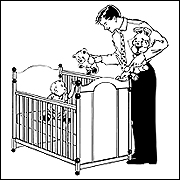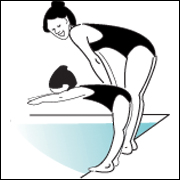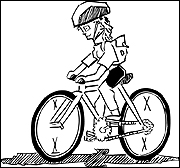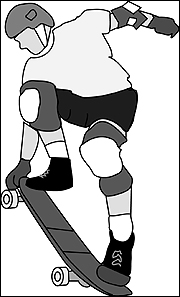Children's surroundings contain a lot of potential hazards. Unintentional injuries are responsible for many injury deaths each year, and it is estimated that 90 percent of unintentional injuries could be avoided. Unintentional injuries are those injuries that could be avoided if necessary precautions are taken. People of all ages can sustain life-threatening unintentional injuries; however, some injuries pose greater risks for certain age groups. The five leading causes of injury death among children under age 15 are motor vehicle injuries, fires and burns, drowning, firearms and suffocation. Parents and caregivers need to know the greatest risk factors for their children and to take the appropriate steps to reduce the risk of unintentional injury.
Table 1
United States' Injury Death Rates by Type of Injury and Age (1996)
| Number of deaths by age group | Birth to 4 | 5 to 9 | 10 to 14 | 15 to 19 |
|---|---|---|---|---|
| Total unintentional injury deaths | 2,895 | 1,564 | 1,824 | 6,735 |
| Selected unintentional injury death types | ||||
| Motor vehicle occupant, traffic-related | 514 | 359 | 531 | 3,566 |
| Pedestrian, traffic-related | 225 | 264 | 234 | 279 |
| Bicyclist, traffic-related | 4 | 81 | 112 | 65 |
| Drowning | 533 | 223 | 225 | 388 |
| Residential fire | 451 | 192 | 97 | 70 |
| Fall | 55 | 30 | 21 | 94 |
| Firearm | 17 | 27 | 94 | 238 |
| Suffocation and choking | 532 | 57 | 77 | 67 |
| Poisoning | 57 | 18 | 34 | 190 |
Source
Compressed Mortality files, National Center for Health Statistics, Centers for Disease Control and Prevention. As cited in Grossman, David C. (2000). The History of Injury Control and the Epidemiology of Child and Adolescent Injuries. The Future of Children, 10(1), 23-52.
Infants
Children age 4 and under are more likely than any other age group to sustain unintentional injuries that result in death and disability. Injuries resulting from drowning and blocked airways are responsible for the majority of unintentional injury deaths among infants. These injuries include suffocation, choking and strangulation. These types of injury are largely preventable, and parents and caregivers should understand how they occur in order to take the necessary steps to prevent their likelihood.
Sleeping in adults' beds
Some parents may choose to sleep with their infants for easy access when the baby cries and to simplify nighttime feedings. However, this can be a very dangerous practice. A preferred practice is to place the baby's crib near the bed. Four major patterns have been identified that result in an infant's suffocation while sleeping in adult beds:
- An adult may roll over onto the infant causing the baby to suffocate.
- An infant may suffocate after becoming entrapped or wedged between a mattress and another object, such as the bed frame, a wall or other furniture.
- An infant's airway may become obstructed when lying face down on a waterbed mattress.
- An infant can be strangled when rails or openings in headboards or footboards are wide enough to allow the baby's body to pass through while entrapping the head.
 Baby crib safety
Baby crib safety
Strangulation and suffocation may occur in cribs that have older, unsafe designs. Before using a crib, look for a Juvenile Products Manufacturers Association certification seal indicating that the crib meets current safety standards. The following safety precautions should also be taken:
- Ensure that the crib has no missing, improperly placed, loose or broken hardware.
- Look for splinters and rough edges that could injure the baby.
- Check the spacing between crib slats to ensure that the baby's body cannot slide through the opening. There should be no more than 2-3/8 inches between the slats — a distance equal to the width of a can of soda pop.
- Only use tight-fitting mattresses so the baby cannot become wedged between the mattress and the side of the crib.
- Ensure that corner posts are not more than 1/16 of an inch above the end panels. This will prevent a baby's clothing from catching on the post and leading to the possibility of strangulation. If the crib has a canopy, the corner posts should be at least 16 inches high.
- Look for cracked or peeling paint to avoid lead poisoning.
- To reduce the risk of Sudden Infant Death Syndrome (SIDS), always place infants on their backs during naps or at bedtime. Parents were previously told to place infants on their stomachs to sleep; however, doctors and nurses now believe this may be dangerous. If your infant was born with a birth defect, spits up after eating, or has breathing or heart problems check with your pediatrician about the best sleeping position for your baby. In addition, always remove soft items such as pillows or comforters from the crib. These soft items may cause infants to rebreathe exhaled air and suffocate.
In addition to airway obstruction injuries, infants also experience a large number of unintentional injuries resulting from falls. One of the most common products responsible for falls is baby walkers.
Baby walkers
Walkers are responsible for more injuries than any other nursery product. Most of these injuries result from falling down stairs or tipping over while the child crosses uneven surfaces. Eighty percent of these accidents occur while young children are being supervised. The Consumer Products Safety Commission has developed new standards to reduce the risk of falls. New baby walkers must be too wide to fit through average-sized doorways and they must have features that will stop the walker at the edge of a step. If you use a baby walker, ensure that it has a "Meets New Standard" label. Before you place a child in a baby walker, follow these safety tips:
- Close doors or place gates at the top of stairways.
- Always keep the child in view.
- Only use the walker on smooth surfaces to prevent it from tipping over.
- Prevent the child from going near hot surfaces.
- Place all electric cords out of the child's reach.
- Prevent the child from going near sources of water such as toilets, bathtubs and swimming pools.
Toddlers and preschoolers
As children begin to crawl and walk, they become exposed to many more potential hazards. Their natural tendency toward curiosity may lead them into dangerous situations. In addition, parents may underestimate their children's abilities. Items such as medicines, household cleaners and cigarette lighters should always be kept out of children's reach. Following are some other products that pose a risk for young children.
Small toys
Children have a natural tendency to place objects in their mouths. If a toy is smaller than 1-1/4 inches in diameter and 2-1/4 inches in depth, the toy should be kept away from children under 3 years of age. Small parts testers can be purchased to test objects; however, another option is to test objects with a toilet paper tube. Only toys that do not fit through the hole should be accessible to young children. In addition, parents should select products carefully, keep them in good repair and dispose of items that could put children at risk for injury.
Balloons
Latex balloons cause the greatest number of toy-related choking deaths among children each year. To prevent suffocation or choking, children under the age of 8 should not be given uninflated balloons. Uninflated balloons should always be stored out of reach of young children. An adult should always supervise when children in this age group play with inflated balloons. Always deflate and throw away balloons after use and discard balloon pieces immediately.
Window covering cords
Young children may become entangled in window covering pull cords. When possible, keep cords out of children's reach by adjusting cords to their shortest length. Also, ensure that items such as cribs and climbing equipment are placed away from windows to prevent children from climbing to reach the cords.
 Water safety
Water safety
Drowning is the leading cause of accidental death among children between the ages of 1 and 4. Many of these deaths occur in residential swimming pools; however, other sources of open water can also be dangerous. To reduce the risk of drowning, parents of children of all ages should take a few precautions.
Tips for parents and caregivers:
- Learn CPR.
- Empty buckets when they are not in use. Five-gallon buckets can be particularly dangerous for small children.
- Teach children to swim. Whether they have had lessons or not, children should always be supervised while swimming. Flotation devices should not be used as a substitute for supervision. Even when using flotation devices, children should remain in shallow water until they become skilled swimmers.
- Ensure that children are always under adult supervision when swimming or playing in water. Adults should remain undistracted while watching children in bathtubs, swimming pools, or at the beach.
Additional tips for swimming pool owners:
- Swimming pool owners should ensure that a 4-foot high fence or barrier surrounds their entire swimming pool. There should be no footholds or handles on the fence.
- Keep rescue equipment by the pool.
- Do not allow children to play around the pool because they could accidentally fall in. Keep toys out of and away from the pool, because they may attract curious children.
- Place a safety cover on swimming pools when they are not in use. Completely remove the cover before using the pool, because swimmers may become trapped under covers that remain partially in place.
- If a child is missing, always check the swimming pool first.
School-aged children
The leading cause of unintentional injury-related death in this age group is motor vehicle accidents. In addition, children in this age group participate in a variety of activities that could result in non-fatal injuries. The following products pose great risks for children in this age group, but the recommended precautions can reduce the risk of serious injury or death.
 Bicycles
Bicycles
With the exception of automobile accident fatalities and drowning, injuries resulting from bicycle accidents are associated with more deaths among children than any other product. Many of these deaths are caused by head injuries that could be prevented if children consistently wear helmets while riding their bicycles. The following tips will also help prevent the risk of bicycle injuries:
- When selecting helmets, parents should ensure that helmets meet current CPSC safety standards.
- Children should learn to wear a helmet every time and everywhere they ride their bicycles. This becomes a natural process if children begin wearing helmets when learning to ride their bikes.
- Ensure that helmets are worn correctly. Bicycle helmets should be comfortable and snug, but not too tight. Helmets should be worn level on top of the head and straps should always be buckled.
- Help children understand and obey traffic laws as they learn to ride their bicycles.
- Provide adult supervision until children develop safe bicycle riding skills.
 Skates and skateboards
Skates and skateboards
Children between the ages of 5 and 14 are at great risk for injuries associated with roller-skates, in-line skates, and skateboards. Younger children in this age group are particularly at risk because they are still developing the cognitive and motor skills needed to perform these activities well. The majority of deaths associated with skating and skateboarding result from collisions with automobiles. The following steps can help reduce the risk of injuries associated with these products:
- Ensure that children consistently and correctly use the proper safety equipment. Children should wear properly fitted helmets, wristguards, elbow guards and knee pads while skating and skateboarding.
- Restrict beginners to smooth surfaces in low-traffic areas to reduce the risk of accidents.
- Provide adult supervision until children develop the appropriate skills.
Fireworks
Although fireworks may only be used a few times each year, they are responsible for a number of serious injuries. Many of these unintentional injuries result from improper use of fireworks, and typically involve burns to the hands, eyes and head. The following steps should be taken to reduce the risk of injuries associated with fireworks.
- Read and follow all label directions.
- Always supervise older children when they are lighting fireworks. Never allow children under the age of 10 to play with fireworks, including sparklers.
- Ensure that everyone is out of range when lighting fireworks.
- Light fireworks in open areas away from homes and motor vehicles, and ensure that the ground is not dry.
- Always keep a bucket of water handy for emergencies and to pour on any fireworks that do not ignite.
- Keep unused fireworks away from the area where fireworks are being lit.
- Never try to relight fireworks if they do not go off.
- Never hold fireworks in your hands when lighting them.
- Always demonstrate responsible behaviors around fireworks, because children may imitate your actions.
Firearms
An estimated 40 percent of homes contain some type of firearm for recreation or for protection. Firearms that are kept for protection are more likely to remain loaded, unlocked and stored within children's reach.
Note
These weapons are also much more likely to kill a family member or friend than an intruder
The majority of firearm-related unintentional deaths occur in the adolescent age group, but younger children are also at risk. Children and adolescents are less able to make safe decisions about firearms because of their inexperience, impulsivity and lack of reasoning abilities. Because about 40 percent of children's unintentional shooting deaths occur in the homes of relatives and friends, you should discuss the risk of firearms with your children, whether or not you own a firearm. There are more than 200 million privately owned firearms, making it unrealistic to think your children will not encounter a gun. You can reduce the risk of unintentional injury and death from firearms by understanding why children and adolescents are at great risk.
- Children and adolescents are curious
If they suspect there is a gun in a home, they may seek it out and show it to their friends. Therefore, it is very important to keep firearms unloaded and locked out of children's reach. Store ammunition in a different location. Always use safety devices on all firearms. - Children may have difficulty distinguishing between real and toy guns
Teach them to assume that all guns are loaded and dangerous and never to touch firearms. Tell your children to inform an adult if they find a gun or if they see another child with a gun. - Children and adolescents are influenced by their peers
Talk with the parents of your children's friends and learn if they have guns in their homes.
Adolescents
With increased independence comes a greater likelihood that adolescents will participate in risk-taking behaviors. About 60 percent of adolescent deaths result from unintentional injuries. The majority of these deaths are caused by motor vehicle accidents; the second leading cause of accidental death in this age group is from drowning and the third, from firearm injuries.
Motor vehicles
Adolescents have the highest death rates in motor vehicle accidents of any age group. One factor is that adolescents are much less likely than other age groups to be secured by seat belts. Adolescents typically do the majority of their driving during daylight hours; however, about half of their fatalities occur after dark. Adult supervision should occur for the first few months when beginning drivers drive in potentially hazardous conditions, such as rain, snow and at night.
Kids in cars
Motor vehicle accidents are the leading cause of death resulting from unintentional injuries among children ages 14 and under. Failure to restrain all passengers is the greatest risk factor in accidents. Consistent and correct use of child restraint seats and seatbelts can prevent many injuries and deaths. The following tips can help reduce the risk of life-threatening injuries in these accidents.
- Children under 12 years of age should be restrained in the back seat. This is true regardless of whether or not the vehicle has air bags.
- Infants should be placed in rear-facing restraint seats until they reach the age of 1 and weigh 20 pounds. Rear-facing restraint seats should never be placed in the front seat of a vehicle that has an air bag. Before installing a child restraint seat, read the instruction manual and your automobile owner's manual to be certain that you install the restraint seat correctly. An estimated 80 percent of children are not properly secured when riding in vehicles.
- Children that are at least 1 year of age and weigh between 20 and 40 pounds should be placed in forward-facing restraint seats.
- Children between the ages of 4 and 8 and weigh between 40 and 80 pounds should be secured in car booster seats when they ride in vehicles.
- All vehicle passengers who weigh over 80 pounds should be restrained by seat belts every time and everywhere they ride.
Safety equipment and adult supervision
It is very important that children always use appropriate safety equipment, which includes things like bicycle helmets, life preservers in and around the water, and elbow pads, knee pads, and a helmet when rollerblading. Safety equipment can protect children from many injuries.
Note
Even when using equipment, children still need to be monitored and supervised closely by adults
Parents should not let children take more risks when playing, just because children are using safety equipment. Children are the safest from injury when they use safety equipment and receive close adult supervision requiring them to keep risky behaviors to a minimum.
Smoke detectors: A proven strategy for avoiding children's injury and death from house fires
Note
House fires and other unintentional fire-related injuries killed 810 children and adolescents under 20 years of age in the United Stated during 1996
About 75 percent of deaths due to house fires are caused by a victim's inhalation of smoke and lack of oxygen, not because of extensive burns. Some children are at greater risk for injury and death from a house fire.
Experts study the risk factors for residential fire deaths from two perspectives: the risk of a fire starting in a home and the risk of injury or death once the first has started. The likelihood of a house fire is greatest in homes with faulty heating systems and homes where smokers live. The risk of child injury or death once the fire has started is greatest when adults are present who drink alcohol, when the child is under 5 years of age, and if the family resides in a trailer home, a house that is older than 20 years, and/or a home with two or fewer exits.
The presence of a working smoke detector is a major source of protection against children's injury and death from house fires. Some experts estimate that working smoke detectors lead to a 50 percent to 70 percent reduction in deaths. The Oklahoma City Smoke Alarm Project distributed free smoke alarms in targeted neighborhoods, provided written educational pamphlets and visited families at home to guarantee that their smoke alarms were working. Six years after the project, there was an 81 percent decrease in house fire-related injuries in the neighborhoods where the project operated, compared to a 7 percent decline in the rest of Oklahoma City. The dramatic decline in fire-related injuries is largely due to the free smoke alarm distribution and the written and in-person educational efforts.
Conclusion
Every day, children encounter a number of potential hazards. While it may be impossible to eliminate all dangers, parents and caregivers can take steps to reduce the risk of unintentional injury. One important step is to become aware of the greatest risk factors that apply to children in particular age groups. With this knowledge, parents and caregivers can take the necessary steps to protect the children in their households.
Sources
- Mallonee, S. (2000). Evaluating injury prevention programs: The Oklahoma City Smoke Alarm Project. The Future of Children, 10(1), 164-174.
- Runyan, C.W., Bangdiwala, S.I., Linzer, M.A., et al. (1992). Risk factors for fatal residential fires. New England Journal of Medicine, 327: 859-63.
References
- Bonnie, R. J., Fulco, C. E., and Liverman, C. T. (Eds.). (1999). Reducing the Burden of Injury: Advancing Prevention and Treatment. Committee on Injury Prevention and Control, Division of Health Promotion and Disease Prevention, Institute of Medicine. Washington, D.C.: National Academy Press.
- DiLillo, D., Tremblay, G. C. (In press). Maternal and Child Reports of Behavioral Compensation in Response to Safety Equipment Usage. Journal of Pediatric Psychology.
- Grossman, David C. (2000). The History of Injury Control and the Epidemiology of Child and Adolescent Injuries. The Future of Children, 10(1), 23-52.
- U.S. Public Health Service. (1998). Back to Sleep: Reduce the risk of Sudden Infant Death Syndrome (SIDS).